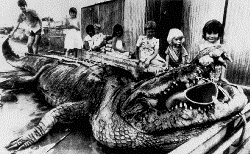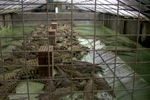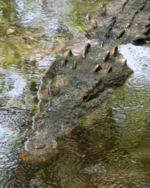| Crocodiles | ||||||||||
|---|---|---|---|---|---|---|---|---|---|---|

Nile Crocodile
|
||||||||||
| Scientific classification | ||||||||||
|
||||||||||
|
Mecistops Crocodylus Osteolaemus See full taxonomy. |
A crocodile is any species belonging to the family Crocodylidae (sometimes classified instead as the subfamily Crocodylinae). The term can also be used more loosely to include all members of the order Crocodilia: i.e. the true crocodiles, the alligators and caimans (family Alligatoridae) and the gharials (family Gavialidae). The crocodiles, colloquially called crocs, are large aquatic reptiles that live throughout the Tropics in Africa, Asia, the Americas and Australia. Crocodiles tend to congregate in freshwater habitats like rivers and lakes and wetlands and sometimes in brackish water. Some species, notably the Saltwater Crocodile of Australia, Southeast Asia and the Pacific islands often lives along the coastal areas as its name implies. It is also known to venture far out to sea. They mostly feed on a wide variety of vertebrates like fish, reptiles, and mammals, sometimes with invertebrates like mollusks and crustaceans, depending on species. They are an ancient lineage, and are believed to have changed little since the time of the dinosaurs.
Appearance and physical traits
Crocodiles are the most advanced of all reptiles despite their prehistoric look. Unlike other reptiles they have a four-chambered heart, diaphragm and cerebral cortex. Their external morphology on the other hand is a sign of their aquatic and predatory lifestyle. A crocodile’s physical traits allow it to be a successful predator. They have a streamlined body that enables them to swim faster. They also tuck their feet to their sides while swimming, which makes the animal even faster, by decreasing the amount of water resistance. They have webbed feet, although not used to propel the animal through the water, this allows it to make fast turns and sudden moves in the water or initiate swimming. Webbed feet are an advantage in shallower water where the animals sometimes move around by walking.
Crocodiles are very fast over short distances, even out of water. They have extremely powerful jaws and sharp teeth for tearing flesh, but cannot open their mouth if it is held closed, hence there are stories of people escaping from the long-snouted Nile Crocodile by holding its jaws shut. Indeed, zoologists will often subdue crocodiles for study or transport by taping their jaws or holding their jaws shut with large rubber bands cut from automobile inner tubes. All large crocodiles also have sharp welters and powerful claws. They have limited lateral movement in their neck, so on land one can find protection by getting even a small tree between the crocodile's jaws and oneself.
Age
There is currently no reliable way of measuring crocodile age, although several techniques can be used to derive a reasonable guess. The most common method is to measure lamellar growth rings in bones and teeth - each ring corresponds to a change in growth rate which typically occurs once a year between dry and wet seasons. Bearing these inaccuracies in mind, the oldest crocodilians appear to be the largest species. C. porosus is estimated to live around 70 years on average, and there is limited evidence that some individuals may exceed 100 years. One of the oldest crocodiles recorded died in a zoo in Russia apparently aged 115 years old. The news report did not identify the species.
Size
Size greatly varies between species. From the exceptionally small dwarf crocodile to the enormous saltwater crocodile, they range in all sorts of sizes. Large species can often reach huge sizes over 5 or 6 metres and weigh well over 1000kg. Despite their large adult size, crocodiles start their life interestingly small. Crocodiles when first hatched are around 20 cm. Sizes vary depending on the season and health and blood composition of the mother. The largest species of crocodile, also Earth's largest reptile, is the Saltwater Crocodile, found in northern Australia and throughout South-east Asia. According to some scientists, there are no truly reliable records of any non-prehistoric crocodiles over 8.64m.
In the town of Normanton, Queensland, Australia, there is a fibreglass mould of a crocodile called "Krys the Croc.," shot in 1958 by Krystina Pawloski, who found the animal on a sandbank on the Norman River. There is a report of a saltwater crocodile in Australia that was 8.2 m long. There is also a skull of a salt water crocodile from Orissa, India that is very large and the animal is estimated to have been 6.4 to 7 m long.
The other two larger certifiable records of complete crocodile are both of 6.2 m crocodiles. The first crocodile was shot in the Mary River in the Northern Territory of Australia in 1974 by poachers and measured by wildlife rangers. The second crocodile was killed in 1983 in the Fly River, Papua New Guinea. In this latter crocodile it was actually the skin that was measured by zoologist Jerome Montague, and as skins are known to underestimate the size of the actual animal, it is possible this crocodile was at least another 10 cm longer.
The largest crocodile ever held in captivity is an Estuarine/Siamese hybrid named Yai (Thai: ใหญ่, meaning big) (born 10 June, 1972) at the famous Samutprakarn Crocodile Farm and Zoo, Thailand. He measures 6 m. in length and weighs 1,114.27 kg.
Another huge captive crocodile was a saltie named Gomek. Gomek was captured by George Craig in Papua New Guinea and sold to St. Augustine Alligator Farm in Florida. Although George captured an even larger crocodile with Gomek, it is uncertain whether this animal is still alive on Green Island in Queensland where George Craig now lives. After many years, Gomek died of heart disease in February 1997. By this stage, he was a very old crocodile. When he died, he was 5.5 m long - as confirmed by St. Augustine Alligator Farm - and probably between 70 and 80 years old.
On June 16, 2006, A 7.1m giant saltwater crocodile in Orissa, India was crowned the world's largest living crocodile. It lives in Bhitarkanika Wildlife Sanctuary and in June 2006, was entered in the Guinness Book of World Records. [1]
Wildlife experts, however, argued that the largest crocodile so far found in the Bhitarkanika was almost 7.62 m which could be traced from the skull preserved by the Kanika Royal Family. The crocodile, probably was shot dead near Dhamara during 1926 and later its skull was preserved by the then Kanika King. The crocodile experts said as per the parameters, the crocodile would be about 7.62 m since the size of the skull was measured one seventh of the total length of the body.
Biology and Behaviour
Crocodiles are ambush hunters, waiting for fish or land animals to come close, then rushing out to attack. As cold-blooded predators, they can survive long periods without food, and rarely need to actively go hunting. The crocodile's bite strength is up to 3,000 pounds per square inch, comparing to just 100 psi for a labrador retriever or 350 psi for a large shark. [1] Despite their slow appearance, crocodiles are the top predators in their environment, and various species have been observed attacking and killing big cats like lions [2], large ungulates and even sharks. [3] A famous exception is the Egyptian Plover which is said to enjoy a symbiotic relationship with the crocodile. According to unauthenticated reports, the plover feeds on parasites that infest the crocodile's mouth and the reptile will open its jaws and allow the bird to enter to clean out the mouth.
Crocodiles eat fish, birds, mammals and occasionally smaller crocodiles. Wild crocodiles are protected in many parts of the world, but they also are farmed commercially. Their hide is tanned and used to make leather goods such as shoes and handbags, whilst crocodile meat is also considered a delicacy in many parts of the world. The most commonly farmed species are the Saltwater and Nile crocodiles, while a hybrid of the Saltwater and the rare Siamese Crocodile is also bred in Asian farms. Farming has resulted in an increase in the Saltwater Crocodile population in Australia, as eggs are usually harvested from the wild, so landowners have an incentive to conserve crocodile habitat. Crocodiles are more closely related to birds and dinosaurs than to most animals classified as reptiles , the three being included in the group Archosauria ('ruling reptiles'). See Crocodilia for more information.
Danger to humans
The larger species of crocodiles can be very dangerous to humans. The Saltwater and Nile Crocodiles are the most dangerous, killing hundreds of people each year in parts of South-East Asia and Africa. Mugger crocodiles and possibly the endangered Black Caiman, are also very dangerous to humans. American alligators are less aggressive and rarely assault humans without provocation. Crocodiles are the leading cause of animal related deaths as of 2001.
Crocodile blood
Scientists in the United States have isolated a powerful agent in crocodile blood (crocodillin) which could help conquer human infections immune to standard antibiotics. The discovery was made thanks to the curiosity of Jill Fullerton-Smith, a BBC science producer filming a documentary on salt-water crocodiles in Australia. [4]
Crocodile as food
In some countries such as Australia, Thailand and South Africa, the consumption of crocodile meat can be observed. The meat is white and its nutritional composition compares favourably with that of more traditional meats. It does tend to have a slightly higher cholesterol level than other meats. Crocodile meat has a delicate flavour and its taste can be complemented, if not masked, by the use of powerful marinades. Choice cuts of meat include backstrap and tail fillet.
Trivia
- The crocodile gets its name from the Greeks who observed them in the Nile river. The Greeks called them krokodilos, a compound word from kroke, which means "pebbles" and drilos, which means "worm". To the Greeks, this "worm of the stones" was so named because of the crocodiles habit of basking in the sun on gravel-covered river banks.
- Petsuchos was the name given by the Greeks to the live crocodile at Crocodilopolis in Ancient Egypt, which was worshipped as a manifestation of the Egyptian god Sobek; the deification of crocodiles.
- Crocodile embryos do not have sex chromosomes, and unlike humans sex is not determined genetically. Sex is determined by temperature, with males produced at around 31.6 degrees celsius, and females produced at slightly lower and higher temperatures. The average incubation period is around 80 days, and also is dependent upon temperature.[5]
- Many of the extinct crocodiles were herbivorous.
Taxonomy of the Crocodylidae
Most species are grouped into the genus Crocodylus. The two other living genera of this family are both monotypic: Osteolaemus and Tomistoma.
- FAMILY CROCODYLIDAE
- Subfamily Mekosuchinae (extinct)
- Subfamily Crocodylinae
- Genus Euthecodon (extinct)
- Genus
Osteolaemus
- Dwarf Crocodile, Osteolaemus tetraspis (there has been some controversy whether or not this is actually two species; current thinking is that there is one species with 2 subspecies: O. tetraspis tetraspis & O. t. osborni)
- Genus
Crocodylus
- American Crocodile, Crocodylus acutus
Slender-snouted Crocodile, Crocodylus cataphractus (Recent DNA studies suggest that this species may actually be more basal than Crocodylus, and belong in its own genus, Mecistops)
Orinoco Crocodile, Crocodylus intermedius
Freshwater Crocodile, Crocodylus johnstoni
Philippine Crocodile, Crocodylus mindorensis
Morelet's Crocodile or Mexican Crocodile, Crocodylus moreletii
Nile Crocodile or African Crocodile, Crocodylus niloticus (the subspecies found in Madagascar is sometimes called the Black Crocodile)
New Guinea Crocodile, Crocodylus novaeguineae
Mugger Crocodile, Marsh Crocodile, or Indian Crocodile, Crocodylus palustris
Saltwater Crocodile or Estuarine Crocodile, Crocodylus porosus
Cuban Crocodile, Crocodylus rhombifer
Siamese Crocodile, Crocodylus siamensis
- American Crocodile, Crocodylus acutus
- Subfamily Tomistominae (recent studies
may show that this group is actually more closely
related to the Gavialidae)
- Genus Kentisuchus (extinct)
Genus Gavialosuchus (extinct)
Genus Paratomistoma (extinct)
Genus Thecachampsa (extinct)
Genus Kentisuchus (extinct)
Genus Rhamphosuchus (extinct) - Genus
Tomistoma
- False gharial or Malayan gharial,
Tomistoma schlegelii
Tomistoma lusitanica (extinct)
Tomistoma cairense (extinct)
- False gharial or Malayan gharial,
Tomistoma schlegelii
- Genus Kentisuchus (extinct)
In popular culture
- In the fictional Peter Pan series by J.M Barrie, a large crocodile serves as Captain Hook's worst fear, as it bit his hand off, leaving him with his hook. It also ate a clock, and thus ticking lets Hook know if the Crocodile is approaching.

- In the Disney movie The Wild, two abandoned pet crocodiles that dwell in the sewer guide the protagonists to the harbor rather than eating them.
- In the Disney movie The Emperor's New Groove and corresponding TV shows and sequels, the villain, Yzma, has a pet crocodile that lives in a chamber that is accessed by a lever next to another lever that accesses her secret lab. Often she comically pulls the wrong lever, falling into the pit, and returns with the crocodile latched onto her, and she says 'Why do we even have that lever?'.
- The Cheburashka series of books (by Eduard Uspensky) and animated films feature Crocodile Gena as one of the main characters. He works in a zoo as a crocodile.
References
- ^ "Orissa crocodile recognised as world's largest", Reuters, 2006-06-16. Retrieved on [[2006-06-18]].
- Crocodilian Biology Database, FAQ. "How long do crocodiles live for?" Adam Britton. [6] Retrieved 9/11/2006
Further reading
- Iskandar, DT (2000). Turtles and Crocodiles of Insular Southeast Asia and New Guinea. ITB, Bandung.
- Crocodilian Biology Database, FAQ. "How long do crocodiles live for?" Adam Britton. [7]
External links







